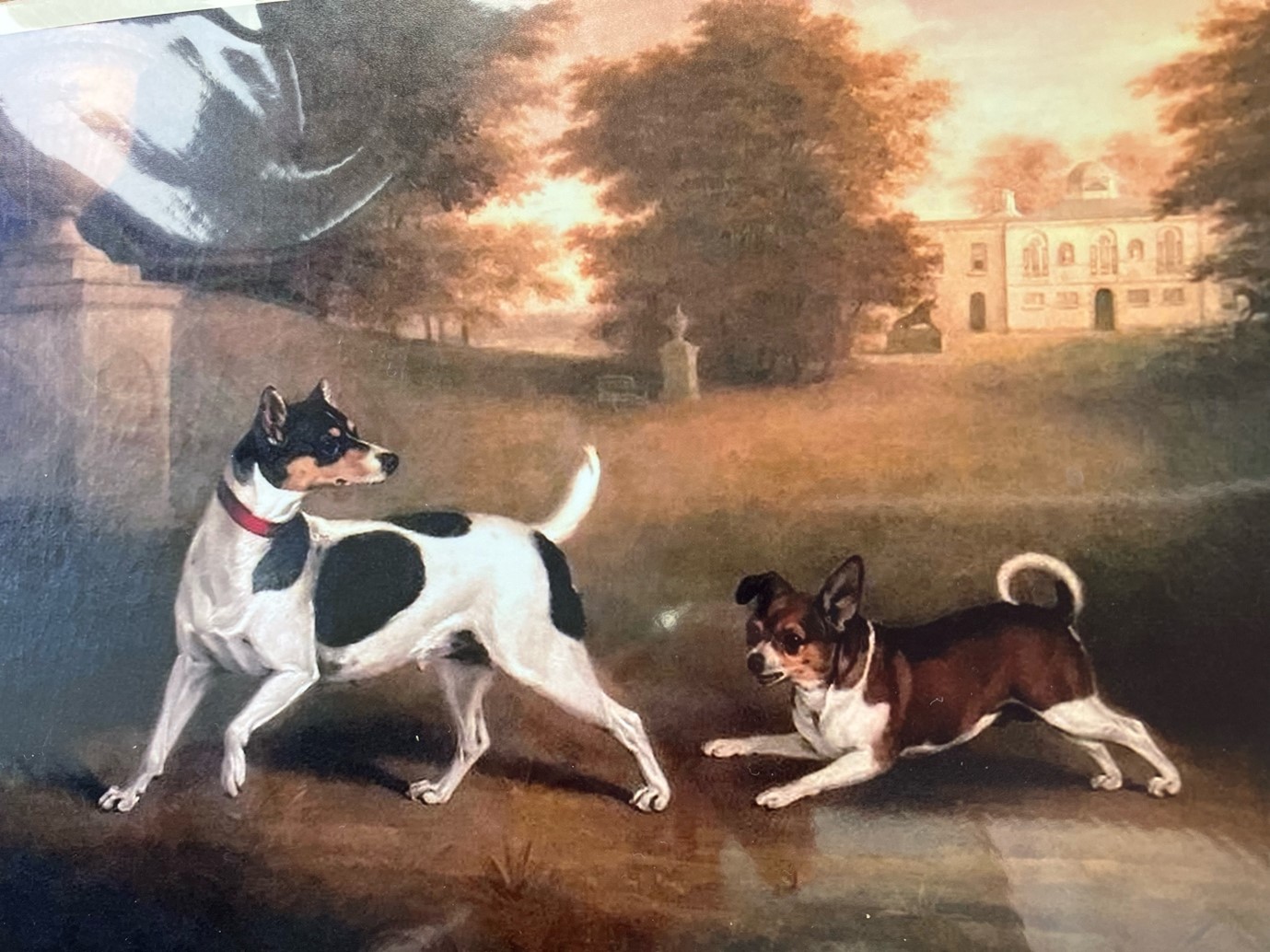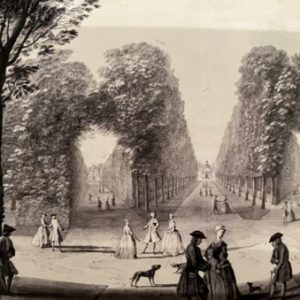An A to Z of the Chiswick House Archives: D is for Dogs
In the fourth edition of our A-Z archive series, volunteer archivist Cluny Wells picks man’s best friend for her letter D.

The 2022 Chiswick House Dog Show was held very recently at Chiswick House Gardens, and prompted us to consider the long standing relationship Chiswick has with all the dogs who love and have loved to visit our wonderful Grounds, and about the story of dogs from the dim and distant past.
A brief history
The nearest common ancestor to the modern dog is the extinct late Pleistocene era Wolf and not the modern Wolf. It is believed that humans first began to domesticate dogs somewhere between 15,000 and 40,000 years ago, as depicted on rock paintings. A Dr Maria Guagnin, a specialist in prehistoric human-animal relationships had found from her two most recent digs in north west Saudi Arabia, in 2017, the earliest visual evidence of the human domestication of dogs. The hunting scenes depicted on rock faces, not only showed dogs biting an ibex, but also showed dogs on leads – some tied to a hunter’s waist. She dated those rock carving to be between 8000 and 6000 BC.
By the 18th and 19th centuries we find that dogs with well to do owners, were either pampered as lapdogs or used as working dogs, or if owned by the lower stratas of society were seen as pests and were treated badly or even cruelly. The idea of a Lady caring more for her dog than her children, and of the upper crust looking after their hunting dogs and appreciating their courage and companionship is reinforced by paintings commissioned at that time. Edwin Landseer, the famous Victorian painter of animals, painted a typical series of paintings: Dogs in Low Places and High Places, which showed the dog in pampered and humble settings.
At this time of growing industrialisation and urbanisation in Britain attitudes changed toward dogs, as Urbanites had little experience with raising farm animals eventually for slaughter, while more and more families kept pets. Pet dogs had individual names and lived in the house, unlike pets in rural settings.
Hunting dogs were bred for specific purposes, and these dogs were kept in kennels to live lives of relative ease and prosperity.
Frederick, Prince of Wales, had houses at Cliveden and Kew in the 1740s and 1750s. Frederick’s relationship with his parents, King George II and Queen Caroline, was strained for much of his adulthood, and his homes at Cliveden and Kew were retreats where he could get away from the family tension. He also kept dogs at both houses. At Cliveden, he paid for the construction of dog kennels in 1750. At the end of the same year he rented truffle-hunting dogs, from Christmas 1750 until Lady Day (March 25) 1751.
Truffle Hounds

Truffle HoundThis is a type of Truffle Hound, similar to the ones the Prince of Wales rented. The Prince of Wales’ rental of the truffle hunting dogs tells us that using dogs to find these valuable fungi is a much older idea than most modern truffle-hunters might realise Indeed, dogs are better for hunting truffles than pigs, because dogs are far less likely to eat the truffle once they’ve found it.
Depictions of dogs at Chiswick
Even though the 3rd Earl of Burlington would have been familiar with the Royal Family, including Frederick’s pet dogs, there is no evidence that he kept pet dogs himself – whereas we do know that he had a herd of deer at Chiswick, and had cages built for pet birds outside.

Dogs were depicted in drawings and engravings of the Earl’s family and guests in the Grounds by William Kent, and other artists such as Rigaud who engraved this scene above (detail shown) in 1733.
Lord Burlington’s near neighbour William Hogarth lived just a stone’s throw away, and he always had a Pug dog. Several were named Pugg, and his most well-known pug was called Trump.

As a boy, the future 5th Duke of Devonshire visited his grandmother, Lady Burlington, at Chiswick and played in the Grounds with his dog and siblings. His nickname even then was Canis, and as an adult he still appeared to be more comfortable with his dogs than with his family.

Dogs in Chiswick today
In more recent times Chiswick House and Gardens Trust have welcomed dogs and their best friends to come to Chiswick , and much care and consideration has been shown to our dog visitors with their owners, as well as to all users of the Grounds. For local and visiting dogs these include providing covered outside areas around the new café, offering drinking water for dogs and plenty of spaces for interesting walks and contact with other dogs, with only a small percentage of the grounds requiring leads to be worn or short leads. There is one small ‘Dog Free Area’ area in the Grounds.
Dog waste bins and bags are provided courtesy of The Dogs Trust and CHOW (Chiswick House Organised Walkers)
The first dog show at Chiswick was held in September 2004, on the cricket pitch area, and was organised by CHOW in association with Chiswick House Friends, and sponsored by John D. Wood (estate agents) It was not much more than a tent, a ring and a couple of dogs.Since then it has grown over the years with the help of many local businesses and celebrity guests. Everyone is welcome. By the time of its 7th year there were over 430 dogs registered and it had more than 2,500 human visitors.
September 25th 2022 was the date of this year’s Dog Show with the title of “Harry Pointer and the Philosopher’s Bone”. It had almost 600 dogs pre-registered even before the big day! Today it may be the biggest free dog show in London. It is still organised by Chiswick House Friends and CHOW, and still sponsored by John D. Wood.
Beloved pets of the family
Lilly was a much loved pet dog of the Devonshire family, and her monument in the Grounds of Chiswick House bears a Latin inscription to her memory. In translation it reads:
Beneath this monument lies Lilly, a little dog and the most good-natured of all dogs, of long time a most beloved companion, and in beauty and loyalty, a model of canine genius. She was free of the weaknesses of humankind while manifestly exhibiting its virtues.She was entirely without malice, but not without love. This tomb, and her mistress’s tears bear witness to her virtues. Her memory will not perish from the earth
Lord Byron, a close friend of the Devonshire family, had a Newfoundland dog called ‘Boatswain’ who died at the age of five from rabies, and on his tomb were written these words:
Near this Spot
are deposited the Remains of one
who possessed Beauty without Vanity,
Strength without Insolence,
Courage without Ferocity,
and all the virtues of Man without his Vices.
John Hobhouse 1808.